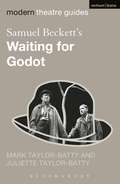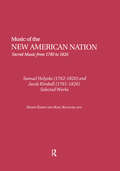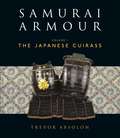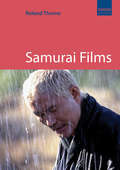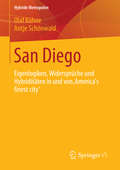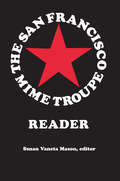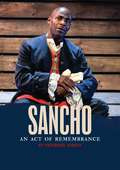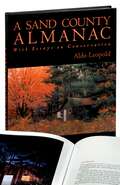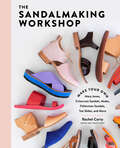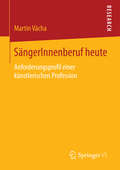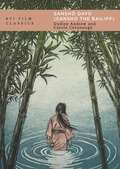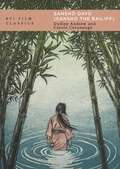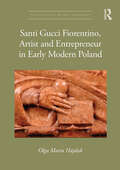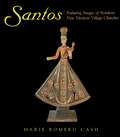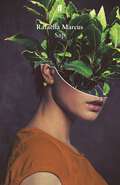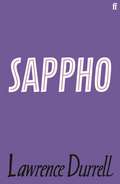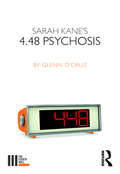- Table View
- List View
Samuel Beckett's Waiting for Godot (Modern Theatre Guides)
by Mark Taylor-Batty Juliette Taylor-Batty"An impressively complete survey of the play in its cultural, theatrical, historical and political contexts." - David Bradby, co-editor of Contemporary Theatre Review Samuel Beckett's Waiting for Godot is not only an indisputably important and influential dramatic text -it is also one of the most significant western cultural landmarks of the twentieth century. Originally written in French, the play first amazed and appalled Parisian theatre-goers and critics before receiving a harshly dismissive initial critical response in Britain in 1955. Its influence since then on the international stage has been significant, impacting on generations of actors, directors and audiences.
Samuel Hirszenberg, 1865–1908: A Polish Jewish Artist in Turmoil (The Littman Library of Jewish Civilization)
by Richard Cohen Mirjam RajnerSamuel Hirszenberg is an artist who deserves to be more widely known: his work intertwined modernism and Jewish themes, and he influenced later artists of Jewish origin.Born into a traditional Jewish family in Łódź in 1865, Hirszenberg gradually became attached to Polish culture and language as he pursued his artistic calling. Like Maurycy Gottlieb before him, he studied at the School of Art in Kraków, which was then headed by the master of Polish painting, Jan Matejko. His early interests were to persist with varying degrees of intensity throughout his life: his Polish surroundings, traditional east European Jews, historical themes, the Orient, and the nature of relationships between men and women. He also had a lifelong commitment to landscape painting and portraiture.Hirszenberg’s personal circumstances, economic considerations, and historical upheavals took him to different countries, strongly influencing his artistic output. He moved to Jerusalem in 1907 and there, as a secular and acculturated Jew who had adopted the world of humanism and universalism, he strove also to express more personal aspirations and concerns. This fully illustrated study presents an intimate and detailed picture of the artist’s development.
Samuel Holyoke: Selected Works (Music of the New American Nation: Sacred Music from 1780 to 1820 #12)
by Harry EskewThis series presents the music of early American composers of sacred music・psalmody, as it was called・in collected critical editions. Each volume has been prepared by a scholar who has studied the musical history of the period and the stylistic qualities of the composer. The purpose of the series is to present the music of important early American composers in accurate editions for both performance and study. This volume presents representative compositions by two American psalmodists, Samuel Holyoke and Jacob Kimball, who were actively engaged in the reform of American psalmody during the 1790s and early 1800s. American compositions were often criticized for two features: their failure to conform to the harmonic norms of European art music and their often vigorous, animated musical style, which was sometimes considered lacking in a reverent spirit appropriate for use in public worship
Samuel Holyoke: Selected Works (Music of the New American Nation: Sacred Music from 1780 to 1820)
by Harry Eskew Karl KroegerThis series presents the music of early American composers of sacred music・psalmody, as it was called・in collected critical editions. Each volume has been prepared by a scholar who has studied the musical history of the period and the stylistic qualities of the composer. The purpose of the series is to present the music of important early American composers in accurate editions for both performance and study. This volume presents representative compositions by two American psalmodists, Samuel Holyoke and Jacob Kimball, who were actively engaged in the reform of American psalmody during the 1790s and early 1800s. American compositions were often criticized for two features: their failure to conform to the harmonic norms of European art music and their often vigorous, animated musical style, which was sometimes considered lacking in a reverent spirit appropriate for use in public worship
Samurai Armour: Volume I: The Japanese Cuirass
by Trevor AbsolonFor beauty, precision and strength, nothing has ever matched the combination of form and function found in the armour of the samurai. For a samurai, the consummate warrior, his suit of armour was so much more than 'just' protective equipment that could save his life in the heat of battle – it was the embodiment of his personality, social status and very soul. This volume, the first in a two-part series on the armour of the samurai, traces first the history of the samurai themselves and then examines the history and evolution of the cuirass or dou, the armour protecting the samurai's chest. Drawing on over 20 years of research and technical work by Trevor Absolon, a leading expert, this is a complete study of this fundamental aspect of samurai armour construction. Illustrated throughout with photographs and diagrams, this is more than just a detailed technical exploration, it is a meditation on a process that was, and still is, nothing short of an art form.
Samurai Armour: Volume I: The Japanese Cuirass
by Trevor AbsolonFor beauty, precision and strength, nothing has ever matched the combination of form and function found in the armour of the samurai. For a samurai, the consummate warrior, his suit of armour was so much more than 'just' protective equipment that could save his life in the heat of battle – it was the embodiment of his personality, social status and very soul. This volume, the first in a two-part series on the armour of the samurai, traces first the history of the samurai themselves and then examines the history and evolution of the cuirass or dou, the armour protecting the samurai's chest. Drawing on over 20 years of research and technical work by Trevor Absolon, a leading expert, this is a complete study of this fundamental aspect of samurai armour construction. Illustrated throughout with photographs and diagrams, this is more than just a detailed technical exploration, it is a meditation on a process that was, and still is, nothing short of an art form.
Samurai Films
by Roland ThorneSamurai films are a wonderful combination of frenetic action sequences, moving personal drama and philosophical observations on loyalty and violence, all set against the spectacular backdrop of pre-industrial Japan. Many mainstream directors, from Hollywood and elsewhere, have been inspired and influenced by the genre. Want to know where George Lucas got some of the major plot ideas for Star Wars: A New Hope? Check out Akira Kurosawa's The Hidden Fortress. Interested in seeing the film that arguably inspired the whole Spaghetti Western genre? Have a look at Kurosawa's Yojimbo. Want to see one of the major inspirations for Quentin Tarantino's Kill Bill films? Look no further than Toshiya Fujita's Lady Snowblood. If you want to know more about Samurai films, then this is the book for you. Roland Thorne covers the history of this popular cult genre, including the influence it's had on world cinema, as well as analysis of all key films. Classics such as Kurosawa's Seven Samurai and Hiroshi Inagaki's Samurai Trilogy are included, as well as more recent films, such as Aragami, The Twilight Samurai and The Hidden Blade. Samurai Films is Roland Thorne's first book.
San Diego: Eigenlogiken, Widersprüche und Hybriditäten in und von ‚America´s finest city‘ (Hybride Metropolen)
by Olaf Kühne Antje SchönwaldDie Entwicklungspfade von San Diego sind beeinflusst von der sozialen, kulturellen und ökonomischen Verschiedenheit der beiden Räume San Diego und Tijuana. Diese Verschiedenheit hat sich heute zu einer Ressource für Hybridisierungen entwickelt. Hybriditätsforschungen betrachten Kultur als Prozess, in dem sich Eigenes und Fremdes gegenseitig beeinflussen und bedingen. Mittels qualitativer Methoden werden die Biographien der hybriden Grenzmetropole nachvollzogen und die soziale Konstruktion von (Grenz-)Raum aus einer neuen Perspektive beleuchtet. Ergänzt wird diese Perspektive durch eine Analyse medialer Präsenz von San Diego und Tijuana.
The San Francisco Mime Troupe Reader
by Susan Vaneta MasonThe San Francisco Mime Troupe Reader is a long-overdue collection of some of the finest political satires created and produced by the Tony Award-winning company during the last forty years. It is also a history of the company that was the theater of the counterculture movement in the 1960s and that, against all odds, has managed to survive the often hostile economic climate for the arts in the United States. The plays selected are diverse, representing some of the Troupe's finest shows, and the book's illustrations capture some of the Troupe's most memorable moments. These hilarious, edgy, and imaginative scripts are accompanied by insightful commentary by theater historian and critic Susan Vaneta Mason, who has been following the Troupe for more than three decades. The Mime Troupe Reader will engage and entertain a wide range of audiences, not only general readers but also those interested in the history of American social protest, the counterculture of the 1960s-particularly the San Francisco scene-and the evolution of contemporary political theater. It will also appeal to the legions of Troupe fans who return every year to see them stand up against another social or corporate Goliath.
Sancho: An Act of Remembrance (Oberon Modern Plays)
by Paterson JosephBorn on a slave ship in 1729, later becoming the fellow actor and friend of David Garrick and the first black person of African origin to vote in Britain, the life of Charles Ignatius Sancho was full of surprising, moving and funny twists. As Thomas Gainsborough paints his famous portrait, we are given an insight into the forgotten but true story of an African man who dared to act, write, sing, dance and voice his political opinion with wit and charm. One of the UK's finest actors, Paterson Joseph (Peep Show, Emperor Jones, Survivors) brings Sancho to life in this world premiere at the Burton Taylor Studio.
A Sand County Almanac
by Aldo LeopoldAldo Leopold's A Sand County Almanac has enthralled generations of nature lovers and conservationists and is indeed revered by everyone seriously interested in protecting the natural world. Hailed for prose that is "full of beauty and vigor and bite" (The New York Times), it is perhaps the finest example of nature writing since Thoreau's Walden. Now this classic work is available in a completely redesigned and lavishly illustrated gift edition, featuring over one hundred beautiful full-color pictures by Michael Sewell, one of the country's leading nature photographers. Sewell, whose work has graced the pages of Audubon and Sierra magazines, walked Leopold's property in Wisconsin and shot these photographs specifically for this edition, allowing readers to see Sand County as Leopold saw it. The resulting layout is spectacular. But the heart of the book remains Leopold's carefully rendered observations of nature. Here we follow Leopold throughout the year, from January to December, as he walks about the rural Wisconsin landscape, watching a woodcock dance skyward in golden afternoon light, or spying a rough-legged hawk dropping like a feathered bomb on its prey. And perhaps most important are Leopold's trenchant comments throughout the book on our abuse of the land and on what we must do to preserve this invaluable treasure. This edition also includes two of Leopold's most eloquent essays on conservation, "The Land Ethic" and "Marshland Elegy." With this gift edition of A Sand County Almanac, a new generation of readers can walk beside one of America's most respected naturalists as he conveys the beauty of a marsh before sunrise or the wealth of history to be found in an ancient oak.
The Sandalmaking Workshop: Make Your Own Mary Janes, Crisscross Sandals, Mules, Fisherman Sandals, Toe Slides, and More
by Rachel CorryA leading teacher in the artisanal craft of shoemaking presents an inspiring step-by-step guide to making sandals, featuring 14 of her original contemporary designs.
SängerInnenberuf heute: Anforderungsprofil einer künstlerischen Profession
by Martin VáchaMartin Vácha identifiziert die typischen beruflichen Anforderungen an „klassische“ SängerInnen und leitet daraus Empfehlungen an das einschlägige Bildungssystem ab. Der Autor untersucht sowohl die sozio-ökonomischen Rahmenbedingungen des SängerInnenberufs als auch die persönlichen Erfahrungen von SängerInnen in Bezug auf deren beruflichen Werdegang, um daraus 23 berufsspezifische Anforderderungen auf personaler, kulturbetrieblicher und curricularer Ebene zu formulieren. Die Verwurzelung des SängerInnenberufs in der Kindheit, die Integration musikdramatischer, konzertanter und gesangspädagogischer Aufgabenfelder, die Wechselhaftigkeit sängerischer Karrieren und der zu beobachtende intensive Wettbewerb bilden die empirische Grundlage für die vom Autor formulierten Anregungen.
Sanitation Details
by L. WoolleyA companion volume to Drainage Details, the two volumes provide a compact and exact source of reference dealing with the drainage of buildings from sanitary appliance through the underground drainage network, to the final outfall.
Sanitation Details
by L. WoolleyA companion volume to Drainage Details, the two volumes provide a compact and exact source of reference dealing with the drainage of buildings from sanitary appliance through the underground drainage network, to the final outfall.
Sansho Dayu (BFI Film Classics)
by Dudley Andrew Carole CavanaughKenji Mizoguchi's masterpiece Sanshô Dayû (1954) retells a classic Japanese folktale about an eleventh-century feudal official forced into exile by his political enemies. In his absence, his children fall under the corrupting influence of the malevolent bailiff Sansho. In their study of the film, film scholar Dudley Andrew and Japanese literature professor Carole Cavanaugh highlight the cultural, aesthetic and social contexts of this film which is at once rooted in folk legend and a modern artwork released in the aftermath of World War II. This edition includes a new foreword by the authors in which they consider the film's contemporary parallels in modern slavery and children torn from their families by malevolent authorities.
Sansho Dayu (BFI Film Classics)
by Dudley Andrew Carole CavanaughKenji Mizoguchi's masterpiece Sanshô Dayû (1954) retells a classic Japanese folktale about an eleventh-century feudal official forced into exile by his political enemies. In his absence, his children fall under the corrupting influence of the malevolent bailiff Sansho. In their study of the film, film scholar Dudley Andrew and Japanese literature professor Carole Cavanaugh highlight the cultural, aesthetic and social contexts of this film which is at once rooted in folk legend and a modern artwork released in the aftermath of World War II. This edition includes a new foreword by the authors in which they consider the film's contemporary parallels in modern slavery and children torn from their families by malevolent authorities.
Santi Gucci Fiorentino, Artist and Entrepreneur in Early Modern Poland (ISSN)
by Olga Maria HajdukThe original research in this book analyzes the artistic activity of Santi Gucci (1533– c.1600), a Florentine sculptor active in Poland in the second half of the sixteenth century, and his workshop.Chapters examine the organization of the artistic workshop (sculpting and masonry) and the model of the artist’s functioning as an entrepreneur in Renaissance Poland, using Santi Gucci’s activity as an example. Gucci shaped the image of Polish sculpture in the sixteenth century for more than 50 years, even though his work has not yet been fully examined. The author sets Gucci’s emigration within the context of the cultural exchanges between Italy and Poland that contributed to the development of the Polish Renaissance.The book will be of interest to scholars working in art history, Renaissance studies, architectural history and economic history.
Santi Gucci Fiorentino, Artist and Entrepreneur in Early Modern Poland (ISSN)
by Olga Maria HajdukThe original research in this book analyzes the artistic activity of Santi Gucci (1533– c.1600), a Florentine sculptor active in Poland in the second half of the sixteenth century, and his workshop.Chapters examine the organization of the artistic workshop (sculpting and masonry) and the model of the artist’s functioning as an entrepreneur in Renaissance Poland, using Santi Gucci’s activity as an example. Gucci shaped the image of Polish sculpture in the sixteenth century for more than 50 years, even though his work has not yet been fully examined. The author sets Gucci’s emigration within the context of the cultural exchanges between Italy and Poland that contributed to the development of the Polish Renaissance.The book will be of interest to scholars working in art history, Renaissance studies, architectural history and economic history.
Santos: Enduring Images of Northern New Mexican Village Churches
by Marie Romero CashRichly illustrated with examples of eighteenth- and nineteenth-century art from northern New Mexico's village churches, Santos is an in-depth investigation into the artistic heritage of the New Mexican santero (saint maker). It is also an important study of northern New Mexican artisans and their craft. Along with photographer Jack Parsons, Marie Romero Cash visited every church in the region and documented, identified, and measured each santos. Together they photographed more than 500 pieces, including 19 moradas (places of worship for Penitentes) and the Archdiocese of Santa Fe Collection housed at the Museum of International Folk Art. Cash's extensive research into these formerly "anonymous" artisans fills a gap in the study of this unique form, making Santos indispensable for art historians and the general reader interested in the culture and art of the American Southwest.
São Paulo Heterotopia: Urban Spaces in Suspense / Urbane Räume in der Schwebe (Architekturen #68)
by Ulrike Böhm Katja Benfer Cyrus Zahiri (eds./Hg.)Public and private, traffic and open space, planned and spontaneous - our idea of a city is characterised by opposites. However, the contributors to this bilingual book show that these poles can also be consciously connected. The urban building blocks from São Paolo present surprisingly idiosyncratic city scenes: People dancing along the motorway, strolling through the stone archipelago, splashing around in front of the city skyline Many of the case studies are linked to the ideas of the Brazilian urban planner Francisco Prestes Maia. As early as in the 1930s, he developed concepts that combine traffic, open space and architecture - a surprisingly contemporary approach. Öffentliches und Privates, Verkehr und Freiraum, Geplantes und Spontanes - unsere Stadtvorstellung ist geprägt durch Gegensätze. Dagegen zeigen die Beitragenden in dem zweisprachigen Band, dass sich diese Pole auch bewusst verknüpfen lassen. Die Stadtbausteine aus São Paolo präsentieren unerwartet eigenwillige Stadtszenen: Tanzende entlang der Schnellstraße, Flanierende durch das Steinarchipel, Planschende vor der Stadtsilhouette Viele der vorgestellten Projekte sind verknüpft mit den Ideen des brasilianischen Stadtplaners Francisco Prestes Maia. Schon in den 1930er Jahren entwickelte er Konzepte, die Verkehr, Freiraum und Architektur zusammendenken - ein überraschend aktueller Ansatz.
Sap
by Rafaella MarcusThe bark creeps up my body like a rising sea level. I wonder what will happen when it reaches my heart.When a woman tells a lie to her girlfriend, a seed is planted that starts to grow in the darkness. Now roots are cracking through the pavement and branches are coming in at the windows. As she starts to see things that no one else can, she becomes the focus of some seriously unwanted attention.A queer urban fable about passion, power and photosynthesis, a contemporary thriller with ancient roots, Rafaella Marcus's Sap, her first full-length stage play, opened at Roundabout @ Summerhall, as part of the Edinburgh Festival Fringe, in August 2022.
Sappho
by Lawrence Durrell'A magician.' The Times'A philosophical play of ideas, exploring loss, war, and incest in Ancient Greece, by the celebrated author of The Alexandria Quartet.Lesbos, Ancient Greece. Lawrence Durrell's intricate play follows vivid characters who represent different attitudes towards the role of the individual in the world, exploring how their lofty ideals are transformed when they become victims of unforeseeable real-life circumstances. Eloquent, tragic, poetic, Durrell's parable is a powerful study of idealism in an imperfect universe, drawing vibrant parallels between the classical world and our modern existence.
Sarah Kane's 4.48 Psychosis (The Fourth Wall)
by Glenn D'Cruz"Everything passes/Everything perishes/Everything palls" – 4.48 Psychosis How on earth do you award aesthetic points to a 75-minute suicide note? The question comes from a review of 4.48 Psychosis’ inaugural production, the year after Sarah Kane took her own life, but this book explores the ways in which it misses the point. Kane’s final play is much more than a bizarre farewell to mortality. It’s a work best understood by approaching it first and foremost as theatre – as a singular component in a theatrical assemblage of bodies, voices, light and energy. The play finds an unexpectedly close fit in the established traditions of modern drama and the practices of postdramatic theatre. Glenn D’Cruz explores this theatrical angle through a number of exemplary professional and student productions with a focus on the staging of the play by the Belarus Free Theatre (2005) and Melbourne’s Red Stitch Theatre (2007).
Sarah Kane's 4.48 Psychosis (The Fourth Wall)
by Glenn D'Cruz"Everything passes/Everything perishes/Everything palls" – 4.48 Psychosis How on earth do you award aesthetic points to a 75-minute suicide note? The question comes from a review of 4.48 Psychosis’ inaugural production, the year after Sarah Kane took her own life, but this book explores the ways in which it misses the point. Kane’s final play is much more than a bizarre farewell to mortality. It’s a work best understood by approaching it first and foremost as theatre – as a singular component in a theatrical assemblage of bodies, voices, light and energy. The play finds an unexpectedly close fit in the established traditions of modern drama and the practices of postdramatic theatre. Glenn D’Cruz explores this theatrical angle through a number of exemplary professional and student productions with a focus on the staging of the play by the Belarus Free Theatre (2005) and Melbourne’s Red Stitch Theatre (2007).
